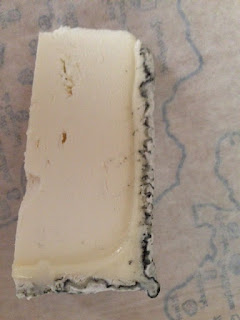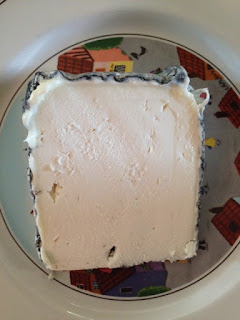While deciding whether or not I wanted to try this rustic fromage, I did some research. I read reviews and couldn't understand why I was seeing descriptions of the aroma it emits being "strong" or "earthy". Nowhere did I read what people should have been saying, that this cheese stinks. It smells like the aftermath of a sinister event that went down behind a dumpster. It smells like death, a rotting corpse or trash that has been left outside in the sun too long. Am I exaggerating? I don't think so. People describe the smell of the durian fruit as pineapple sitting in an outhouse and still want to try it. Well, despite the aroma of this cheese causing alarm, I figured I would at least sample it if I could bring myself to buy some. I imagined sealing the wedge I would purchase in a container to prevent the entire refrigerator from smelling like a food experiment gone wrong, very wrong. With a plan in mind, I finally grabbed a sizeable wedge, plugged my nose and headed to the checkout lane hoping anyone around me wouldn't be offended.
Before I get to the flavor, let me tell you about the name. Tomme or Tome refers to a type of cheese usually produced in the Alps of France or Switzerland. These cheeses are often made with skim milk or leftover milk and are usually earthy and reminiscent of other alpine cheeses. Different types of Tomme cheeses are identified by the regions where they are made. Tomme de Savoie is one of the more famous tomme-style cheeses, and Tomme de Crayeuse is also made in the Savoie region. Tomme de Crayeuse was actually first created somewhat by accident when an affineur, Max Schmidhauser, was trying to find a way to improve a Tomme de Savoie recipe in 1997. Like Tomme de Savoie, Tomme de Crayeuse is made with cow's milk, and it shares many of the same characteristics.
Crayeuse means "chalky" in French. I can't say that this cheese is really chalky, but it's not oily or soft and is somewhat dry without being crumbly. Some claim that the name is a play on words, a way for people to remember its name by associating it with Tom Cruise. It's a bit of a stretch, but now that I know this, I can't help but think of the Scientology activist and American actor every time I see this cheese. Unlike the clean-cut movie star, Tomme de Crayeuse is on the dungy side. The rind is brownish and moldy looking with patches of white and gray. It looks a bit scary, not like something anyone would immediately think of consuming. The mold develops during the ripening stage that takes place in a cave.
As far as the flavor, it's dank, earthy and mushroomy with hints of the barnyard and hay, which is no surprise when you think about the cheese aging in a warm, moist grotto. In the case of this cheese, it's the one time I will say that's it's really OK to skip consuming the rind, though some people like the taste of deep earth and dirt. The more this cheese ages, the scarier the natural rind becomes. That's where you will find strong ammonia flavors after it ages past its prime. The interior also changes as it ages, becoming gummier and the flavor woodier. Where this odd creation succeeds is in the very inner paste. Here you will find a very lovely and nutty, mild cheese that has faint notes of toast and straw. You might even detect a very slight hint of citrus. Heat the cheese and any bitterness or strong lingering flavors soften, creating a wonderfully flavorful gooey mass.
Serve this cheese with selected charcuterie, sausages, fresh fruit, rustic breads or whole-grain crackers. Sneak it in baked dished for an extra bite or serve at room temperature on a cheese board.
 |
| Pinot Noir or Pinot Nero pairs well with Tomme style cheeses. |
Tomme de Crayeuse can take a big bold wine with lots of tannins like a Cabernet Sauvignon or Shiraz. It also pairs well with something more subtle like a Cote de Rhône or Pinot Noir. Gigondas is an excellent choice. You can also try it with an Alsace Riesling, Chardonnay or a Rousette de Savoie. Surprisingly, slightly sweeter wines are a great accompaniment. Give a Tawny Port, Madeira or a Sherry a try. A cheese like this pairs exceptionally well with beer. Try it with Gueuze Girardin or your favorite lager.





